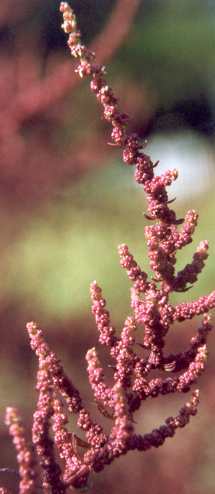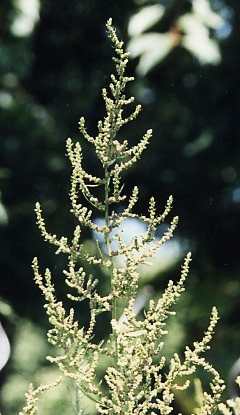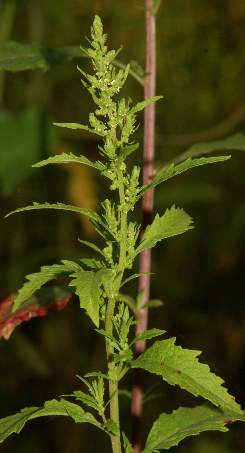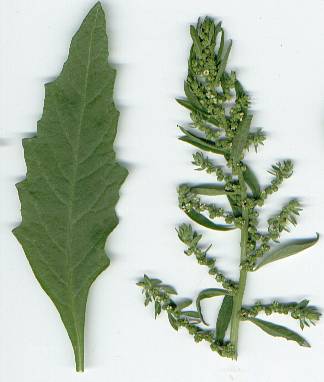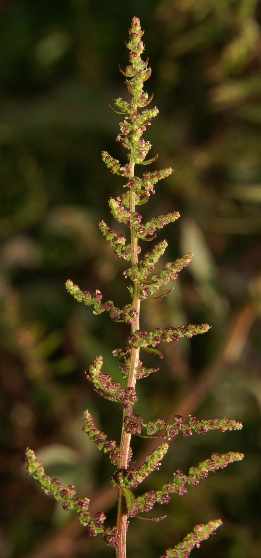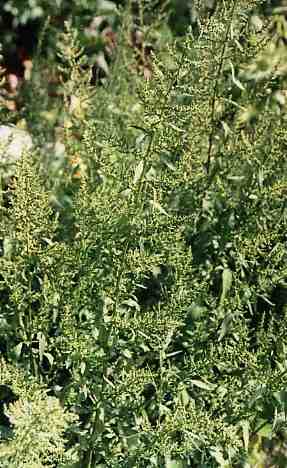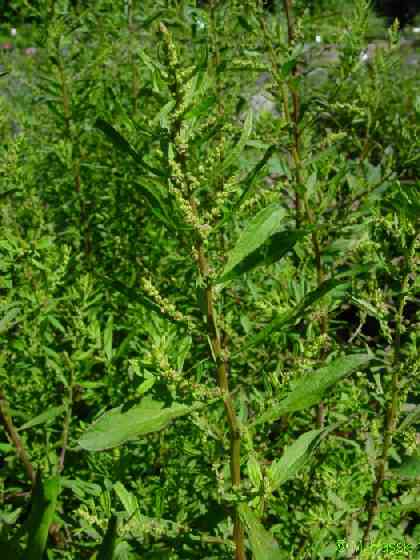The English genus name, goose-foot, is a translation of the scientific genus
name Chenopodium: Greek chen [χήν] goose
and pous [πούς] foot
; it is motivated by the threelobed
leaf shape characteristic of several plants belonging to this group. The
alternate genus name Teloxys also refers to leaf shape; in that
case, the pointed ends of the leaves enshrouding the inflorescence are
indicated (Greek telos [τέλος] end, purpose
and oxys [ὀξύς] sharp, acidic, acute
).
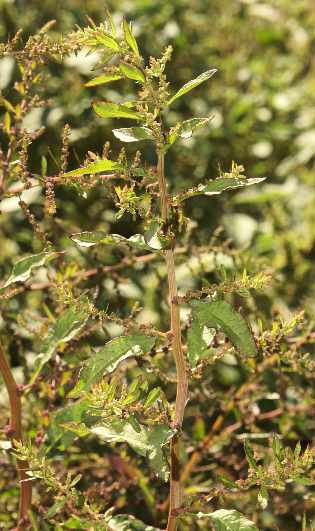
|
|
Epazote flowering plant
|
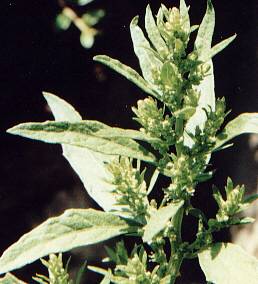
|
|
Epazote (flowering tip)
|
The species name ambrosioides ambrosia-like
probably refers
to the strong odour. Ambrosia [Ἀμβροσία] is, according to Greek
mythology, a nourishment reserved for the Olympic gods, as is implied by its
name: a- [ἀ-] (negation, cognate with English un-) and
brotos [βρότος] mortal
(earlier mrotos [μρότος],
cf. murder, all from the Proto-Indo–European root MR̥TO dead
).
Both conceptually and etymologically, Greek ambrosia [ἀμβροσία] is
closely related to Indian amrita [अमृता].
A very closely related variety (var. anthelminticum) is
cultivated in the Southern States of the US for its potency against intestinal
worms; thus the name wormseed for the plant. To prevent confusion, the
variety used in the kitchen (var. ambrosioides) is usually
called epazote in English. This name is taken from Náhuatl, the
tongue spoken by the Aztecs before the arrival of the Spanish; it is still a
minority language in México and in use among the Indios living around
México City. The Náhuatl name of the plant,
epazōtl, is due to the potent smell of the herb,
which many find disagreeable (epatl skunk
and
tzotl sweat, dirt, excrement
).
A rather different attitude towards epazote’s aroma (or a different aroma in a
cooler climate, see also southernwood for a similar
phenomenon) is made clear by the Scandinavian names: Finnish saitruunasavikka, Swedish citronmålla and
Norwegian sitronmelde contain the name of lemon as first element. As second element, we find in
the Finnish name the name of the botanical genus (goosefoot) and in both the
Swedish and the Norwegian the name of the closely related genus Atriplex (orach),
which is not distinguished from Chenopodium in these tongues. The word melde
or målla is related to English mill
and has in many
Germanic languages relatives meaning flour
and grind
; several species of
genus Atriplex show a pale green, somewhat dusty leaf surface,
as if covered by a layer of fine flour.
In quite many languages, that spice is termed tea
, referring to the
use as a substitute for true tea in preparing aromatic infusions. For example,
we have German Jesuitentee and Spanish té de los jesuitas Jesuit’s tea
,
Catalan te fals false tea
and several names meaning
tea of México
(French thé du Mexique, Turkish
Meksika çayı).
Tea is the dried foliage of the plant Camellia sinensis, which
was first used to prepare aromatic infusions in China. The main types are
green tea (lü cha [绿茶])
and the fermented black tea (hong cha [紅茶], literally red tea
);
half-fermented tea is known as oolong tea (wu long cha [烏龍茶], literally black dragon
).
Oolongs may feature surprising flavours, from chocolate to nutty to fruity; my personal favourite
is the milk-flavoured golden lily tea
(naixiang jinxuan cha [奶香金萱茶]) from Taiwan
which has a distinct, creamy strawberry note. Another favourite is the famous hyacinth-scented
tie guanyin cha [鐵觀音茶] iron Guanyin tea
from Fujian.
Guan-yin is the name of that Lady whom the Vietnamese name Quan Am [Quan Âm] and
is and often referred to as the Goddess of Mercy
.
She is identified with the (male) Boddhisatva of Mercy, Avalokiteshvara [अवलोकितेश्वर]
or Chenresig [སྤྱན་རས་གཟིགས་].
Since more than a
millennium, the word tea
is written 茶 in Chinese,
which has become the source of the names of tea in almost all contemporary
languages. The etymology of tea
becomes slightly complicated, however,
by the presence of two groups of names exemplified by the modern English name
tea and the older term chaa.
In the Mandarin, the Northern dialect of Chinese, the logograph 茶 tea
is pronounced as cha; consequently, this form was borrowed by
languages spoken in those countries that imported their tea by inland traffic
via the silk route, which originated from the Northern region of China. Examples
are Tibetan cha [ཇ་],
Hindi and Urdu cha [चा, چاء]
or chay [चाय, چاۓ, چائے],
Farsi chay [چای],
Arabic shay [شاي],
Dhivehi sai [ސައި],
Amharic shayi [ሻይ],
Tigrinya shahi [ሻሂ],
Russian and Macedonian chaj [чай, чај],
Georgian chai [ჩაი],
Turkish çay,
Greek tsai [τσάι],
Romanian ceai
and Czech čaj.
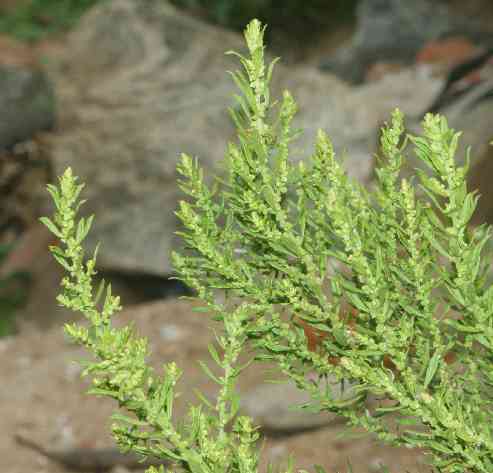
|
|
Flowering epazote
|
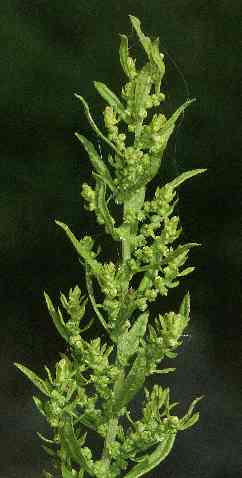
|
|
Epazote plant
|
Some nations neighbouring China have similar names for tea
:
In Thai [ชา],
Korean [차]
and Japanese [茶, ちゃ],
the name is invariably cha. These names
might have proceeded also from the Mandarin form or from
some other Chinese dialect with similar pronunciation of that word.
For example, in Cantonese the sign 茶
is pronounced as chah, rather close to the Mandarin form. This
Cantonese form probably also underlies Portuguese chá, because
Portugal imported its tea from the Cantonese-speaking sea-port Macau.
Yet in most countries where tea entered by seabound trade, the word took a different shape
defined by the Amoy (Minnan) dialect, which is spoken in the coastal Fujian province in
the East of China and in Taiwan. In that area, the glyph 茶
is pronounced te. Thus, the name of tea is teh in
Indonesian and Malay, thee in Dutch and tea in English,
where the vowel was originally pronounced as in lay.
The Dutch and English forms became the predecessors of most names of tea in the
tongues of Western Europe, e. g., French thé, Italian
tè, Norwegian, Swedish and Welsh te,
Finnish and Estonian tee, Latvian tēja,
Yiddish tey [טײ]
and also Hebrew teh [תֵּה].
Also, some South Asian names fall into that pattern, e. g.,
Sinhala te [තේ] and
Telugu teyaku [తేయాకు] tea
.
Some languages have forms of both types, e. g., Kannada
chaha [ಚಹಾ]
and te [ಟೇ] tea
or
Tamil chaya [சாய] tea
and teyilai [தேயிலை] tea leaf
.
In Vietnamese, the plant is denoted che [chè]
and the beverage tra [trà] (spoken approximately cha in the South).
A few languages feature independent terms for tea
, e. g.,
Lithuanian arbata and Polish herbata,
with both indirectly derive from Latin herba herb, medicinal herb
.
